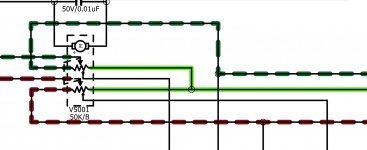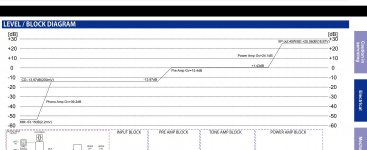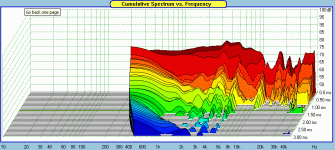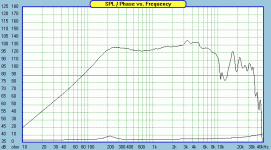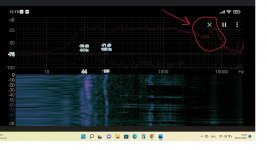Good afternoon everyone. I have a simple question to ask you.
I intend to build Paul Carmody's AMIGA MT kit sold by Part Express.
But the doubt has entered me, since my amplifier is Marantz PM6006 that delivers 45+45 watts at 8 ohms and the sensitivity of this speaker kit is 84 dB.
I have some B&W DM602s that have 90 dB of sensitivity and I have never gone past 12 o'clock on the volume of the Marantz, after that the volume becomes unbearable.
The question is, will this Marantz Pm6006 be enough to move these AMIGA boxes, with 6 dB less sensitivity?
https://www.parts-express.com/Amiga-MT-Tower-Speaker-Kit-With-Knock-Down-Cabinet-300-7124
I appreciate your opinions.
I intend to build Paul Carmody's AMIGA MT kit sold by Part Express.
But the doubt has entered me, since my amplifier is Marantz PM6006 that delivers 45+45 watts at 8 ohms and the sensitivity of this speaker kit is 84 dB.
I have some B&W DM602s that have 90 dB of sensitivity and I have never gone past 12 o'clock on the volume of the Marantz, after that the volume becomes unbearable.
The question is, will this Marantz Pm6006 be enough to move these AMIGA boxes, with 6 dB less sensitivity?
https://www.parts-express.com/Amiga-MT-Tower-Speaker-Kit-With-Knock-Down-Cabinet-300-7124
I appreciate your opinions.
Thank you very much for the contribution.
The calculation gives me that at a distance of 8 feet from the speakers to the listening place, with 10 watts I achieve 85 dB with those speakers that have 84 dB of sensitivity.
The calculation gives me that at a distance of 8 feet from the speakers to the listening place, with 10 watts I achieve 85 dB with those speakers that have 84 dB of sensitivity.
Ideally need to account for at least +20 dB dynamic headroom for un-clipped transients, so the 85 dB limits average listening to ~65 dB, etc..
Good. +20 dB would be multiplying by 10 times the power that I have mentioned. Or 100 watts.
But what would be the comfortable level of listening to music in a room.
I assumed that 85 dB would be adequate. But I really don't know.
If it were so, with my calculations and putting +20 dB for the peaks, I would need 100 watts !!!.
My amp is rated at 45+45 (90) max power and I could never get it more than half way through the volume.
But what would be the comfortable level of listening to music in a room.
I assumed that 85 dB would be adequate. But I really don't know.
If it were so, with my calculations and putting +20 dB for the peaks, I would need 100 watts !!!.
My amp is rated at 45+45 (90) max power and I could never get it more than half way through the volume.
40 watt is 10 + 3 + 3 = 16dB gain up from 84 = Max peak SPL 100dB. With pop music 10dB headroom your max percieved loudness will be 90dB at 1m. Personally I could not live with that. Note that 12 oclock on the amp is considered max gain, more than 12 will distort and eventually burn your speakers.
FWIW, I watch regular TV @ ~67 dB/listening position (LP), ~ 75 dB/THX reference for TV movies and back when I had the system for it, up to 85 dB THX reference for Blu-ray, etc., and some recordings even higher based on what I've measured at live events.
The question Is not that simple...as you gain some more bass extension given by the 10" woofer. A 10" woofer.is generally 90 dB sensitive and after lowpass and baffle step It looses some 5 dB. But that's Just numbers. The midrange unit adds some efficiency since you have One more speaker respect to a 2-way. The tweeter then Is safer to play louder since the crossover point is shifted higher.
Eh eh...the magic of sound (music) reproductionsome recordings even higher based on what I've measured at live events.
That's not true for this amp. The volume control is an attenuation pot, linear according to the service manual. So 12 o clock is 6dB attenuation. 200mV analog input with 0dB attenuation (volume control at max) gives rated 8 ohm output voltage. Digital is level matched so -20dB=200mV RMS (DAC rated output 2.3V RMS at FS, .87 gain in output circuit).40 watt is 10 + 3 + 3 = 16dB gain up from 84 = Max peak SPL 100dB. With pop music 10dB headroom your max percieved loudness will be 90dB at 1m. Personally I could not live with that. Note that 12 oclock on the amp is considered max gain, more than 12 will distort and eventually burn your speakers.
For @ALPUY, it's hard to say for sure how much power you're pushing without knowing what level your content is coming in at or taking some measurements. But your current speakers may not be quite 90dB sensitivity either, if these measurements for the series 3 are any indication, so the sensitivity delta might be smaller than you think. Your new speaker may be an easier load for the amp as well.
Attachments
ALPUY, that looks like a fun kit! Just build it! See how it sounds, that's the fun in it. Power is cheap these days and you can always add more.
Take care,
Nate
Take care,
Nate
Mmmhh....Amiga?! I thought we were talking about the Sunflower 🙄
So no midrange unit...what a shame! I'd embark in building some small 3 way: note that 'small' and '3 way' are essential . There's One design by Wolfteeth, the Purveyors, which fits these requirements. I'd put the drivers on axys and put the crossover out(away) of the box.
So no midrange unit...what a shame! I'd embark in building some small 3 way: note that 'small' and '3 way' are essential . There's One design by Wolfteeth, the Purveyors, which fits these requirements. I'd put the drivers on axys and put the crossover out(away) of the box.
Thank you for your opinionALPUY, that looks like a fun kit! Just build it! See how it sounds, that's the fun in it. Power is cheap these days and you can always add more.
Take care,
Nate
Actually, my intention is to have fun building a DIY speaker. I hear this Paul Carmody AMIGA kit is nice and not fatiguing in sound. I've had the B&W DM602s for many years, but while they sound great (to me), they're very analytical, and after listening to them they get fatiguing. I have been looking at other speakers like Monitor Audio Silver 100: KEF R300 but their price makes me doubt if they are really better than the B&W ones. But my doubt was the low sensitivity of the AMIGA. I won't mess with that, I guess turning up the volume on the amp fixes it.
If budget and space allow, perhaps think about going MTM to increase sensitivity by 6dB.
Here's a design by Jeff Bagby using 2 of the RS180's. The tweeter is no longer available but there is an alternative that can just be dropped in if memory serves.
https://techtalk.parts-express.com/...-rs180-mtm-design?223870-My-RS180-MTM-Design=
Here's a design by Jeff Bagby using 2 of the RS180's. The tweeter is no longer available but there is an alternative that can just be dropped in if memory serves.
https://techtalk.parts-express.com/...-rs180-mtm-design?223870-My-RS180-MTM-Design=
Actually, my intention is to have fun building a DIY speaker. I hear this Paul Carmody AMIGA kit is nice and not fatiguing in sound. I've had the B&W DM602s for many years, but while they sound great (to me), they're very analytical, and after listening to them they get fatiguing. I have been looking at other speakers like Monitor Audio Silver 100: KEF R300 but their price makes me doubt if they are really better than the B&W ones. But my doubt was the low sensitivity of the AMIGA. I won't mess with that, I guess turning up the volume on the amp fixes it.
Almost every B&W speaker has the same kind of response, and it's not very hard to understand why they are seen as fatiguing at times.
Look at measurements from Stereophile fx, as they have measured a lot of them in the same way.
There are of course exceptions, but the majority of them have a lumped up bottom end, 2,5-5k kevlar cone resonance/breakup,look at the pics from a FST mid i added, while this one is a exceptionally well behaved driver, you can see the cone breakup peaks 3,5-5k, and you will find that breakup unattenuated in most of theyre speakers showing in measurements etc., and the top end being "boosted" just as the bottom, a smiley face curve that impresses in hifi stores for a 10 min listen, but gets fatiguing over time.
A well designed notch sometimes 2 intergrated into the XOs and they would be a much better speaker, but maybe have less character and be less 'analytical' 🙂
Attachments
Arez. I greatly appreciate your comment.
Actually I always wondered why the crossover of this speaker is so simple.
For the low pass you only have a 1.2mH inductor and there is neither Zobel nor notch filter. I always thought that cone rupture occurred in aluminum cones.
Could it be that the designers do it on purpose?
If I add a capacitor in parallel to the low pass inductor it will improve the cone break you mention.
I have the Xsim and to attenuate a frequency of approximately 3k, it tells me that the capacitor must be 1.3uF.
I'll do the test.
thank you again
Actually I always wondered why the crossover of this speaker is so simple.
For the low pass you only have a 1.2mH inductor and there is neither Zobel nor notch filter. I always thought that cone rupture occurred in aluminum cones.
Could it be that the designers do it on purpose?
If I add a capacitor in parallel to the low pass inductor it will improve the cone break you mention.
I have the Xsim and to attenuate a frequency of approximately 3k, it tells me that the capacitor must be 1.3uF.
I'll do the test.
thank you again
I don't understand the fatigue meaning, as it's used to descrive a property of a material, Say under stress, heat, cold, and, yes, the cycle of those going up and down. But attributing It to a process which involves the brain other than the umidity in the air or the high SPL at the thympanum, and thinking that the subtly change of a fraction of phase in con.e motion, 'cos that's what we hear and not the electrical side, that may yeld to think that the brain Is involved, yes, but in a distorted way.
picowallspeaker, with the word fatigue I mean that the sound of a speaker becomes annoying, tiring after a period of listening.
This is not the case with all speakers. Generally this happens by exaggeration of certain sound frequencies that are between the mids and the highs.
This is not the case with all speakers. Generally this happens by exaggeration of certain sound frequencies that are between the mids and the highs.
- Home
- Loudspeakers
- Multi-Way
- Speaker Sensitivity
